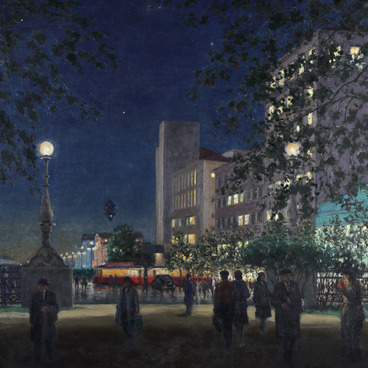The painting of the Ural artist Anatoly Kalashnikov titled “… And Zeus Comes Down as a Golden Rain (Danaë)” was created in 2006 as part of the art project “Danaë. To the Memory of the Masterpiece”. This project was dedicated to the 400th anniversary of the great Dutch artist Rembrandt, who created his famous “Danaë” in 1636 currently housed in the State Hermitage. Artists from Yekaterinburg and Chelyabinsk participated in the creative experiment. Their task was to express their understanding of the ancient plot and show possible ways of its pictorial embodiment from the 21st-century art point of view using the figurative language of modern style painting.
The myth of Danaë is among the most well-known ancient Greek stories. Danaë is the daughter of King Acrisius of Argos and Eurydice and the mother of Perseus. Her name was first mentioned in Homer’s “Iliad”. Acrisius was predicted by an oracle to die at the hands of his grandson. To avoid this, the king imprisoned his daughter. Zeus was captivated by Danaë’s beauty and entered her chamber in the form of golden rain leading to the birth of Perseus.
This episode became the basis for most of the stories about Danaë. The earliest images of it have survived to this day on ancient Greek vases from Athens. In the Middle Ages, Danaë became a symbol of chastity, and her miraculous conception was ruled immaculate. In Renaissance and Baroque art, the theme became popular due to its erotic nature and the opportunity to portray a nude female figure. The subject is popular with modern artists as well.
Anatoly Kalashnikov offers his interpretation of the well-known plot. The famous Ural graphic artist Vitaly Volovich said the following about the artist, “His works represent a fun path to finding harmony. He was cheerful and joyful. He could easily be the entourage of Herr Mozart.” The Russian Danaë by Anatoly Kalashnikov is harmonious and radiant — a fair-skinned beauty with her hair let down, placed in the atmosphere of a Russian village next to a steam bath, a wooden shed, a cart, and a birch, overshadowing her with a golden rain of autumn foliage.
The artist draws the viewer’s attention to the curious details of a modest rural lifestyle: a yoke, a copper samovar with a pipe, a wooden staircase, a barn padlock, and a tub encircled with metal hoops. These elements highlight Kalashnikov’s choice of atmosphere for the heroine of the ancient myth. The painter strives to show the viewers that this ancient story sounds the same no matter what language or culture.
The myth of Danaë is among the most well-known ancient Greek stories. Danaë is the daughter of King Acrisius of Argos and Eurydice and the mother of Perseus. Her name was first mentioned in Homer’s “Iliad”. Acrisius was predicted by an oracle to die at the hands of his grandson. To avoid this, the king imprisoned his daughter. Zeus was captivated by Danaë’s beauty and entered her chamber in the form of golden rain leading to the birth of Perseus.
This episode became the basis for most of the stories about Danaë. The earliest images of it have survived to this day on ancient Greek vases from Athens. In the Middle Ages, Danaë became a symbol of chastity, and her miraculous conception was ruled immaculate. In Renaissance and Baroque art, the theme became popular due to its erotic nature and the opportunity to portray a nude female figure. The subject is popular with modern artists as well.
Anatoly Kalashnikov offers his interpretation of the well-known plot. The famous Ural graphic artist Vitaly Volovich said the following about the artist, “His works represent a fun path to finding harmony. He was cheerful and joyful. He could easily be the entourage of Herr Mozart.” The Russian Danaë by Anatoly Kalashnikov is harmonious and radiant — a fair-skinned beauty with her hair let down, placed in the atmosphere of a Russian village next to a steam bath, a wooden shed, a cart, and a birch, overshadowing her with a golden rain of autumn foliage.
The artist draws the viewer’s attention to the curious details of a modest rural lifestyle: a yoke, a copper samovar with a pipe, a wooden staircase, a barn padlock, and a tub encircled with metal hoops. These elements highlight Kalashnikov’s choice of atmosphere for the heroine of the ancient myth. The painter strives to show the viewers that this ancient story sounds the same no matter what language or culture.


